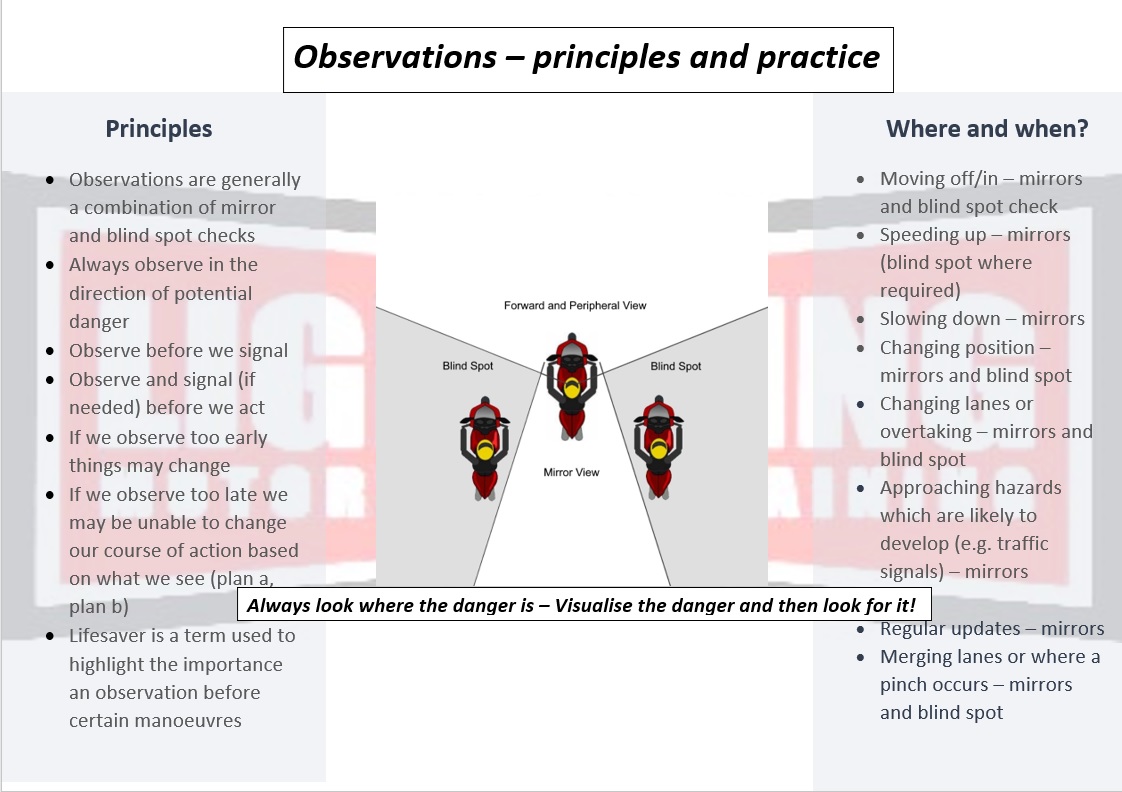Observations - principles and practice

What exactly is an “Observation” or “Lifesaver” during Motorcycle Training?
Much of the training is taken up teaching people to do Observations or Lifesavers. The examiner will expect you to do these looks in the test for the right reason at the right time.
In essence, an observation should afford you the opportunity to change your mind. In other words, they should be done early enough that you can do something different, but late enough that events are not going to change too much. Generally, you would hope to see nothing when you do an observation, and they merely act as an insurance against the day that there is something to see. They should be done so that they do not upset the balance of the bike or make you swerve.
There are six occasions when it is appropriate to do an observation/lifesaver:
i). Moving or turning to the right – including moving round parked vehicles, turning into a side road or changing lane.
ii). Moving or turning to the left – including turning into a side road, moving back to the left having passed a large stationary vehicle, pulling into the side of the road or changing lanes.
iii). Speeding up – either by going into a higher speed limit or pulling away from a standstill.
iv). Slowing down – again entering a lower speed limit, approaching a junction/hazard/roundabout or slowing to stop.
v). Where there is the potential to slow down – approaching green traffic lights, pedestrian crossings, unexpected hazards (horses) or in the event you feel you may have to stop suddenly (children playing by the side of the road).
vi). Updates – keeping a reasonably regular update on what is going on behind you. This can be done just using your mirrors.
FAQ
1/. How do I do an observation?
Easy – look in the mirror and then turn your head to look into your “blind spot”. Generally, the smaller the bike the bigger the blind spot.
2/. What is the difference between an observation and a lifesaver?
Nothing; instructors use the word Lifesaver to emphasise the importance of looking before you turn left or right from a main road into a side road. These observations more often than any other will save your life.
3/. If I miss an observation will I fail my motorcycle test?
Possibly but in general it is a minor fault. However, if the examiner felt there was something you ought to have seen then it will be a serious fault. If you change lanes without observing then normally this would be a serious fault and you will fail.
4/. Can I do too many?
Yes, you can. An observation is often a signal to other road users that you are about to do something. Doing them excessively will simply dilute their effect. Moreover, it pays dividends to look where you are going unless there is a specific reason for doing an observation. To keep a check on things behind a glance in the mirror is adequate.
5/. Which direction should I do my observation/lifesaver?
The direction you turn your head should be based on where you think that the most likelihood of danger is coming from. So, for example if you are turning right the final “lifesaver” will be over your right shoulder. However, say if you are at a set of lights or in the middle lane at a roundabout then you may feel it necessary to look over both shoulders.
The key here is: Is it Safe? You need to be flexible in your approach and clear in your head about the purpose of the observation/lifesaver – which is essentially you are checking that your next action will be safe and if not that you have time to change your mind and do something different. Like insurance the anticipation is that there will be nothing to worry about, but the reason why we do them all the time is to cover the unexpected (like insurance).
6/. Do I have to do them during Module 1?
Yes, but bizarrely only for when you are pulling away. Thus there is no observation during slowing down for the Controlled Stop, but there is for every time you move off, and in particular the lifesaver for the U-turn.
7/. I can’t see the point in them.
Possibly but many people can’t see the point in things like insurance against redundancy; these are often the same people that get made redundant. There may be a link there somewhere. But joking aside, the point of an observation or lifesaver is for you to be able to choose between two different courses of action – Plan A and Plan B. Plan A might be to pull away from the side of the road, whereas Plan B would be to continue to wait for a safe gap. This is the point of doing an observation – to keep you safe.




 Oxford: 01865 777 676
Oxford: 01865 777 676